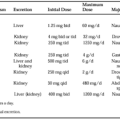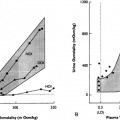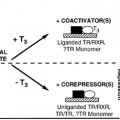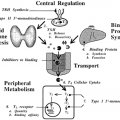CONTROL OF THYROID-STIMULATING HORMONE SECRETION: PHYSIOLOGIC MODULATION
EFFECTS OF AGE AND SEX
TSH is first detectable in fetal serum at ˜13 weeks’ gestational age, approximately the same time as the onset of fetal thyroid iodine uptake. The TSH level remains low until the 18th to 20th
week of gestation, when it rises abruptly. At birth, the serum TSH concentration is ˜10 μU/mL. It then rises rapidly, reaching levels of 75 to 150 μU/mL by 30 minutes after birth.34 Levels then decline and are within the usual childhood range by 2 to 3 days after birth. The serum TSH concentration declines slightly during childhood and adolescence.35
week of gestation, when it rises abruptly. At birth, the serum TSH concentration is ˜10 μU/mL. It then rises rapidly, reaching levels of 75 to 150 μU/mL by 30 minutes after birth.34 Levels then decline and are within the usual childhood range by 2 to 3 days after birth. The serum TSH concentration declines slightly during childhood and adolescence.35
The mean TSH concentration in euthyroid adults is 1.4 to 2.0 μU/mL. Levels do not differ significantly between men and women. Serum TSH levels do not change between adolescence and the age of 60 years. A study of the 24-hour profile of TSH secretion using a sensitive TSH assay found that mean TSH levels were decreased in healthy older men compared to younger control subjects.36 The normal diurnal rhythm was preserved (see Chap. 199).
DAILY RHYTHM
TSH levels rise to a peak between midnight and the early morning hours; a nadir in TSH concentration occurs in late afternoon.21 TSH secretion is pulsatile, most likely in response to pulsatile release of TRH.37 Six to 10 major pulses per 24 hours are noted. The nocturnal rise in TSH levels is associated with increased TSH pulse amplitude. Alterations in dopaminergic and somatostatinergic tone may modulate the TSH pulse size.
Stay updated, free articles. Join our Telegram channel

Full access? Get Clinical Tree







